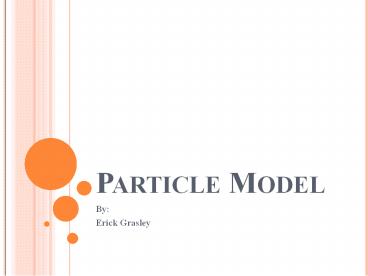Particle Model - PowerPoint PPT Presentation
Title:
Particle Model
Description:
PARTICLE MODEL By: Erick Grasley RATIONALE BEHIND THE PARTICLE MODEL Inadequate ability of current teaching practices to allow the students to accomplish the ... – PowerPoint PPT presentation
Number of Views:136
Avg rating:3.0/5.0
Title: Particle Model
1
Particle Model
- By
- Erick Grasley
2
Rationale behind the Particle Model
- Inadequate ability of current teaching practices
to allow the students to accomplish the
following - Lay necessary ground work of the particle for
further applications. - Understand the role of the particle in chemical
and physical processes. - Apply information to balance reactions beyond the
rudimentary processes of memorizing pseudo
mathematical patterns.
3
Layout of Particle Model Unit
4
Overview of the Particle Model Unit
- Establish necessary ground work for
characteristics of the particle and its
applications. - Incorporate the particle to allow the description
of the processes involved in a physical and
chemical change. - Allow students ample opportunities to apply
knowledge and processes to a wide variety of
tasks involving the particle in its different
forms. - Bridge all aspects of the particle together to
allow the students to achieve a working
understanding of chemical reactions.
5
Introduction of the Particle
- The particle will be introduced using a series of
demonstrations/activities these include - Ethanol and Water in a tube
- Food Coloring in Water
- Diffusion of an Orange
- Thermal Expansion of Water
- Penny (attraction of particles)
- Syringe (compressibility)
6
Applications of the Particle Model
- Phases
- Solid, liquid, and gas as it applies to the
particle. - The spacing and movement of particles in each
phase. - Physical Properties
- Characteristics of the particle associated with
different phases and processes as they change
from one to the other. - Pictorial representation of particles during
various physical changes. - Develop a working understanding for density and
how it applies to, or is affected by the particle.
7
Applications of the Particle Model
- Chemical Properties
- Changing characteristics of the newly combined
particles from new substances. - Pictorial representation of particles during
various chemical changes. - Writing Formulas
- Bridge the gap between the particle (as just a
random shape) to the chemical symbols preparing
them to combine them together. - Balancing Equations
- Final culmination of the particle model that
allows the students to join all materials for
understanding of proper balancing in respect to
the particle and not just the numbers.
8
Application Techniques for the Particle Model
- Demonstrations
- Allow for easy introduction of topics and ideas
into the model. - Introduction Demos
- Chemical Change Indicator Demo
- Labs
- Give students a chance to explore their way
through materials to help lay basic ground work
for the model or modify the model to fit a new
situation. - Physical Change and Mass
- Chemical Change and Mass
- Separation of Mixtures
- Waste B Gone
- Chemical Baggie
- Creating Models
9
Application Techniques for the Particle Model
- Whiteboard Activities
- An application process that allows problems or
situation to be presented to students in a way
that will reinforce/challenge their previous
knowledge. - Help!!! What am I?
- Ranking Tasks for density and particle motion
- Jeopardy Question
- Worksheets
- A technique for quick check of understanding or
to push for further building of knowledge with
the students. Many examples are seen throughout
this unit and many can be added depending upon
your own objectives as teachers.
10
Particle Model Unit Goals
- This unit will allow you to introduce a working
model of the particle that your students can take
with them and use in future classes. - It will give your students opportunities to
construct, understand, and apply the model they
have set up. - In the end this unit will help to alleviate many
misconceptions they bring in, as well as,
reinforce the knowledge that they will learn
throughout.
11
Particle Model Sampler
- Six Unit Activities Stations
- 1. Physical Change
- 2. Chemical Change
- 3. Physical vs. Chemical Changes
- 4. Help !!! What am I?
- 5. Create a Model and Balancing with the
Particle Model - 6. Jeopardy Question
- Each station will last for 10 minutes
- Complete as much of the activity as you can in
given time.
12
Questions?????
- ?































